
BY NICHOLAS CONLEY
Since the dawn of humankind, our particular brand of hairless apes has stared up at the sky wondering how we got here. Is there a higher power? A purpose? Why does the star-nosed mole look so freaky, and why is that lake in Senegal such a bright pink color? Well, we can’t necessarily answer all of life’s questions, but there’s probably only one thing more confusing than the vast secrets of spirituality: the language of mathematics. And strangely enough, math and religion can sometimes be best buddies.
For countless centuries, humans have sought the great answers through the ancient art of geometry, out of the belief that all those weird triangles, cubes, and dodecahedrons might bring us a little bit closer to our creator. Let’s take a look at what the wise, wizardly, white-bearded sages might call “sacred geometry,” and examine the history that geometry has played in religious belief, religious architecture, and … tattoos?
WHAT MAKES GEOMETRY SO SACRED

While the less math-inclined out there might consider geometry something that rose from the depths of Hell rather than anything “sacred,” this ancient art played a major role in the beliefs, designs, and architecture of countless societies throughout history, as shown by Dartmouth. “Sacred geometry” is a broad umbrella term covering many studies, but it relates specifically to the belief that there are geometric patterns, shapes, and mathematical formulas that are central to life, creation, and the universe, according to Sacred Geometry International. These patterns have seeped into every major religion, forming the blueprint for chapels, temples, and classic artwork. So hey, while taking Algebra II didn’t help you budget your paycheck or pay off your student loans, followers of sacred geometry do believe that mathematics will help you get closer to God, Ein Sof, Brahma, or whichever divine figure you might believe in.
That’s the basic idea, but what makes geometric shapes so divine? Just remember, when it comes to combining math and God, don’t get tips from Max, the protagonist of Darren Aronofsky’s Pi, because he had a rough experience with the whole thing.
SYMMETRY IN NATURE

The gristle’s been cut off, so let’s bite down on the red meat. Sacred geometry often centers on the belief that certain shapes in nature, due to their inherent perfection, hold the key to understanding the universe. One example described in Stephen Skinner’s Sacred Geometry: Deciphering the Code is the nautilus shell’s distinctive spiral. See, the nautilus itself is a soft little creature in a big shell. As it matures, it creates bigger chambers for itself within that shell, each new chamber being exactly proportional to the smaller chambers from before. Basically, the nautilus is the world’s best engineer, master’s degrees be damned. Skinner explains in an SF Gate interview that he sees such precise natural patterns as signs of an intelligent higher power.
Next up is the Fibonacci sequence, a pattern wherein every number is the sum of the two preceding numbers. The sequence goes 0, 1, 1, 2, 3, 5, 8, 13, 21, 34, 55, and so on. Fibonacci numbers pop up all throughout nature, as shown by Vihart’s Doodling in Math, whether in the number of spirals on a pinecone, an artichoke’s flowers, or the pattern of leaves on a stem. Seriously, count the spirals on any pinecone in your yard, and prepare for maximum brain meltage.
Then there’s the “golden ratio,” a jazzy name for 1.618, a number found when lots of division creates perfect symmetry. According to LiveScience, the golden ratio is found in countless ancient architectural feats, including the Great Pyramids.
THE GRANDDADDY OF SACRED GEOMETRY IS A GUY NAMED PLATO
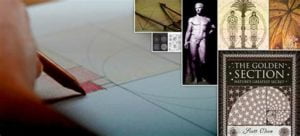
Everyone knows Plato. He was one of the most influential thinkers in human history, and he taught the world all about the dangers of chaining people up in a cave and making them watch shadows. Not surprisingly, ol’ Plato’s brilliant mind got delighted whenever someone mentioned mathematics, particularly geometry. In fact, Dartmouth reported that over his academy was written “Let no one destitute of geometry enter my doors.”
Plato theorized that the sensory world as we knew it was merely a flawed impression of divine reality. According to PBS, Plato tinkered with the ancient idea that the universe was constructed of five geometric shapes, each one symbolic of an element: earth, air, fire, water, and aether. Plato didn’t create these shapes, but people have come to call them the Platonic Solids. These solids look like a bunch of Dungeons and Dragons dice, and include familiar shapes like the cube (earth) alongside weirdo shapes like the icosahedron (water).
Long story short, Plato found geometry crying in the corner, gave it the big, fatherly hug it deserved, and then set it free into the world. While the “solids” theory doesn’t hold up today, Plato’s scientific approach — namely, breaking down the universe’s massiveness into smaller, identifiable parts — was way ahead of his time. Meanwhile, Plato got sacred geometry off to a running start.
ARCHIMEDES WAS PRETTY SOLID, TOO
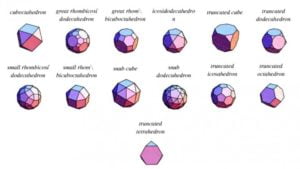
Plato might have kicked off the polygonal football, but Archimedes was the one who caught it and carried those polygons to the next stop on the field. Archimedes — who, for the record, was a highly intelligent Greek mathematician, not a cartoon owl — raised the bar on insanely complex geometric designs, identifying 13 shapes so insanely intricate that they’d make even the Transformers jealous.
According to Wolfram MathWorld, these 13 shapes are called the Archimedean Solids. They include such far-out, trippy shapes as the “great rhombicosi dodecahedron,” as well as the “cubotahedron,” and the somewhat more pitiful “snub cube.” The big difference between the Platonic solids and the Archimedean solids comes down to the level of complexity. The Platonic solids are shapes that can still be turned into play blocks for children, while the Archimedean solids are more like something out of a nightmarish acid trip.
But that’s enough “solid” talk, because all this polygonal discussion is starting to sound a lot like the Sphere in Edwin Abbot Abbot’s Flatland. While it’s hard not to feel pangs of sympathy for the poor little snub cube, let’s examine how sacred geometry has informed real world architecture, culture, and art.
SACRED GEOMETRY IS A BIG DEAL IN ISLAM

As described by the journal Frontiers of Architectural Research, sacred geometry has played a major role in Islamic art and architecture since the eighth century, with the interiors of countless mosques, towers, and palaces being adorned with fascinatingly complex geometric shapes — all following a specific grid, using a ruler and a compass, as shown by The Guardian. Muslim religious art is quite different from Christianity, where churches are usually decorated with literal figurative depictions of Christ, Mary, and the saints. The core beliefs of both religions are mostly the same, so why did their religious art go in such different directions?
According to Valeria Gonzales, a scholar of Islamic civilization, the key factor is that the Qur’an specifically forbids the worship of “idols,” including figurative representations of God. For example, if you dust off the Old Testament, you might remember that whole golden calf business that Moses got so furious about. This ban meant Muslims had to improvise. The fascinating result of this is that rather than use human images, Muslims employed dazzling abstract geometry as a form of religious expression, creating some of the most interesting religious artwork in the world.
This form of sacred geometry complements the philosophies of Plato: Because there are no figurative representations in Islamic religious art, it casts a clear separation between the Earthly human world, and the abstract, complex dimension of the divine.
SACRED GEOMETRY SAYS HELLO TO OTHER MAJOR RELIGIONS OF THE WORLD
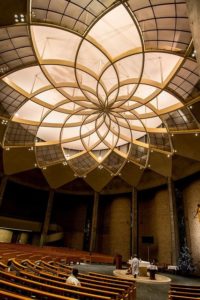
While Islam high-fives sacred geometry like an old childhood friend, all the other big world religions have hung out with the polygons as well. Case in point: Christianity. While Christian art design is usually more literal than the abstract geometry of Islamic art, there are still common geometric rules relating to the architectural designs of churches, steeples pointing toward God, and that most famous of all Christian icons, the cross. Things get cranked up a notch when examining specific churches, such as the Chartres Cathedral in France. According to Stephen Skinner, the architecture of this Gothic cathedral was based on geometric circles. Meanwhile, Prince Charles — yeah, the same Prince Charles who married Diana — has written extensively on the subject, claiming the geometry of every wall, slant, and fixture within the Chartres Cathedral is specific, perfect, and loaded with meaning. Once again, the perfection of geometry symbolizes the perfection of the divine, compared to man: order in chaos.
So yeah, everyone loves these funky shapes. Hinduism is also down with the mathness, specifically fractal geometry, according to academic researchers from South Korea. Hinduism’s sacred shape is a mandala, the intersection of a circle and a square, symbolizing the relationship between humankind and the divine. Hindu temples have actually been planned, designed, and built with the mandala as their geometric center, as described in Pon Kulendiren’s Hinduism: A Scientific Religion.
KABBALAH’S TREE OF LIFE

Judaism is the grandparent of all other Abrahamic religions, so it’s no surprise that good ol’ geometry has tossed its circles into the Jewish world as well. Specifically, geometric symbols are a key part of the ancient Jewish mystical tradition known as Kabbalah. Anyone who has studied Kabbalah can affirm that it’s a fascinatingly complex belief system, loaded with symbolism. The point where geometry and Kabbalah intersect is within the “Tree of Life,” a diagram central to Kabbalistic belief.
As described by religious scholar J. Gordon Melton in The Encyclopedia of Religious Phenomena, the Tree of Life is composed of ten geometric circles — called the Sefirot — and 22 bars. It’s a map of the sacred path between mankind and Ein Sof, the unknowable creator who lies beyond human comprehension. The tree represents the multi-layered process of creation, and Kabbalists endeavor to return to a more divine consciousness by climbing this tree, one branch at a time. As told by the Jewish Virtual Library, the circles in the left column represent the feminine divine qualities of understanding, justice, and glory, while the masculine circles on the right are wisdom, mercy, and endurance. The middle circles represent the balance.
Since it’s Kabbalah, every layer of meaning has billions of additional meanings beneath it. According to Rabbi David Cooper, the Tree of Life contains 32 paths, and each Sephirah — and each person — contains a little Tree of Life on the inside, which also must be navigated.
THE DA VINCI CODE
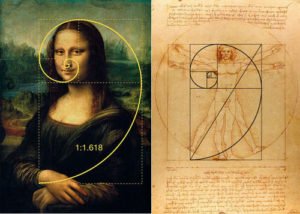
Whooooa, calm down, Dan Brown fans! Mary Magdalene ain’t got nothin’ to do with this, unless her head was a right triangle and her arms were icosahedrons. (They weren’t.) Conspiracy theories aside, Da Vinci did have a lot of insane hidden meanings in his art, as all of his most famous works employ sacred geometry.
See, old Leo was really big on mathematics. According to the Mona Lisa Foundation, one of the major guiding components in his art was that whole “golden ratio” business we talked about earlier: the number 1.618, which creates perfect geometric symmetry. Da Vinci wasn’t the first person to discover this dazzling geometric miracle, but he did give it new prominence and inspired others to, as well. Da Vinci called it “Sectio aurea,” according to ScienceDirect, meaning “golden section.” Da Vinci believed that true, natural beauty only came from drawing proportions that lined up with this ratio.
So yeah, Da Vinci was even more intricate, brilliant, and complicated than we realized. Need more proof? Well, here comes the Museum of Science to the rescue. Its website has a special section where you can play with all of Da Vinci’s most famous works, and pinpoint the golden ratio in Vitruvian Man, the Mona Lisa, The Last Supper, and Annunciation. If a time-traveling Plato and Leonardo had ever met, they probably would’ve poured some wine and talked about math.
THERE’S AN AWESOME FLOWER, TOO
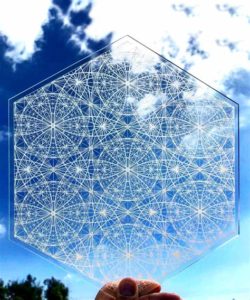
It’s time to talk about the so-called Flower of Life. For the record, this Flower is totally different from the Tree of Life. While a historical thriller novel might try to connect the two in a major plot twist, maybe even having the Flower unlock the Tree — perhaps unleashing a wave of cosmic light? — the Flower of Life isn’t tied to either Kabbalah or the ten Sefirot, other than the fact that both are examples of sacred geometry.
That said, the Flower of Life is also an old-timer, and it’s certainly dated enough to qualify for an Elders of the Universe-level AARP subscription. According to Wolfram Mathworld, this psychedelic arrangement of overlapping circles at least dates back to Ancient Egypt, where it was found within the Temple of Osiris. Evidently, this same geometric symbol also popped its flowery head up within Phoenician art in the the ninth century B.C., so there’s no question that it was important.
In recent years, this fascinating circle arrangement has made its home in the New Age Movement as one of the movement’s most popular symbols. This prominence is largely due to the writings of Drunvalo Melchizedek, a New Age mystic formerly named Bernard Perona, who published the sacred geometry book The Ancient Secret of the Flower of Life, Vol. 1 in 1999, and has been discussing the Flower of Life ever since.
BODY ART
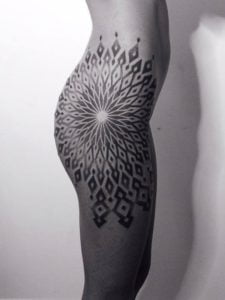

So yes, sacred geometry is really cool. It has played a huge role in countless societies, religions, and movements, with its myriad of perfect shapes appearing in architecture, temples, mosques, churches, and art since the dawn of civilization. However, in the present day, where Pew Research studies show an increasing number of people are choosing to identify as “spiritual, but not religious,” sacred geometry has found a new canvas: the human body.
Really, it makes sense. Though getting a tattoo used to be a threat to scare your parents with, the inkiest art form is now widely accepted. For spiritually inclined people who want to demonstrate their faith but who don’t believe in organized religion, one of the clearest ways they can show their devotion is by tattooing it on their skin. Everyone always says they want a tattoo with deeper meaning, and it’s hard to get much deeper than spiritual beliefs.
Enter the world of sacred geometry tattoos, which Business Insider has called the newest trend in the inking world. These tattoos utilize the gorgeous complex shapes of sacred geometry and have a lot more meaning — plus a lot more beauty — than many tattoos of the past. Furthermore, these tattoos advance the legacy of an ancient tradition that has shaped humanity since those old-fashioned B.C. years. No wonder sites like Tattoo do offer lots of tips and examples on how to choose the sacred geometrical tattoo design that best suits you.
Source: Sacred Geometry
Disclaimer: We at Prepare for Change (PFC) bring you information that is not offered by the mainstream news, and therefore may seem controversial. The opinions, views, statements, and/or information we present are not necessarily promoted, endorsed, espoused, or agreed to by Prepare for Change, its leadership Council, members, those who work with PFC, or those who read its content. However, they are hopefully provocative. Please use discernment! Use logical thinking, your own intuition and your own connection with Source, Spirit and Natural Laws to help you determine what is true and what is not. By sharing information and seeding dialogue, it is our goal to raise consciousness and awareness of higher truths to free us from enslavement of the matrix in this material realm.
 EN
EN FR
FR





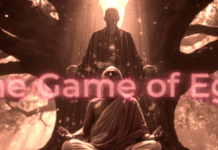





















Music Theory also has lots of Geometry, but no one cares about that :)… https://www.youtube.com/watch?v=46rb2ry4jBg
Does the first image’s dreamtime logo not bother anyone else on here?
MUT SEE
www.biogeometry…